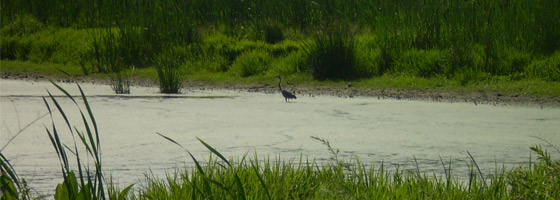Farmland to wetland: Ohio brothers restore property

For Steve and Jerry Panzner, preserving family tradition did not mean maintaining the 80-year-old Panzner vegetable farm; it meant heeding their grandfather Joseph’s call for conservation. After realizing their 150 acres of farm in Copley Township, Ohio was being outcompeted by foreign vegetable sources, they decided to restore the land to its original wetland state. The Panzner Wetland Wildlife Reserve is a highly diverse 104 acres now owned and studied by the University of Akron. It’s what Joseph Panzner may have wanted if the land could no longer be used for farming.
“This is what we grew up with – a real  healthy outlook on the land,” Steve said.
healthy outlook on the land,” Steve said.
Constructing the wetland has been a labor of love for Steve and Jerry, despite a rough start. After being rejected for funding by several sources, including Al Gore, the Panzner brothers finally received a permit to construct a wetland mitigation bank on their property in 1999.
They were doing something unprecedented. First, they were two private individuals whereas the mitigation system was established with the intent for large corporations to replace wetlands they destroyed. Instead, local entities paid Steve and Jerry to construct the wetland, giving them needed credits. The Panzners were also the first to request a contract for a high Category II wetland. Out of the three category rankings for Ohio wetlands, a high Category II status means the wetland is functioning moderately and there is high presence of flora and fauna. Most mitigation bank contracts are for Category I wetlands, meeting minimal standards. Since its completion, the Panzners’ wetland is now a Category III, with superior function and integrity.
The brothers attribute the health of the wetland to their individualized design that worked with the land and soil they had on the farm. They took everything they knew in their combined 54 years of farming and did the opposite.
“Jerry and I both found out that building wetlands is just as fun as farming,” Steve said. “Wetlands are farming in reverse.”
After spending most of their lives doming land and keeping water away from roots, Steve and Jerry contoured their land aggressively to avoid using a gate to release water like many wetland mitigation projects. They carefully removed 18 inches of dark, oxygenated peat soil to provide low-oxygen soil for wetland vegetation. This was done with a track hoe to prevent soil disruption that encourages the growth of invasive species which often plague other mitigation wetlands. This meticulous planning and construction between 2000 and 2003 produced a low-maintenance piece of land. Their design was so effective, there has been a Ph.D paper written on why the technique worked.
“Our wetland doesn’t need people. It doesn’t need people to manage gates, valves and water,” Steve said. “It just needs to be left alone.”
Clearly, the wetland is thriving on its own. The Panzners can look out their back door to the sight of bald eagles, osprey, many shorebirds, minks and Ohio’s only remaining original colony of endangered wood turtles. They provided wooded wetland areas as well as areas with deep water to encourage a wide variety of species. Just don’t ask Steve how many there are.
“Oh jeez, criminey, the list goes on!” he said.
The only thing that brings Steve and his brother more enjoyment than the wetland they cultivated is sharing it with others. When they began the project, they had two goals. One was to become the best wetland mitigation bank in Ohio. They checked that off the list when the EPA granted them that designation. Their other goal was to give it away to an educational institution. In early January, they donated the 104.67-acre Panzner Wetland Wildlife Reserve to the University of Akron to be used as a living laboratory. Still owning part of the property with his home, Steve said he is thrilled to watch honeybee pollination tracking and other research happening right outside his door.
“It’s been a real journey and it’s been a heck of a lot of fun,” Steve said. “It’s the best possible thing we could have done with this property.”
Though the Panzners’ wetlands represent only 104.67 out of 800,000 acres of wetlands in Ohio, they may be the most well-loved of them all. The Panzners hope that the wetlands can be passed on for use by future generations, along with their love of the land.





Rena Jackson
February 7, 2021 at 5:05 pm
Hello Jerry,
I was thinking of you and when I looked you up , it’s amazing to see what you and Steve have accomplished.The Jackson’s. I’m Rena. This is amazing … Kudos guys.